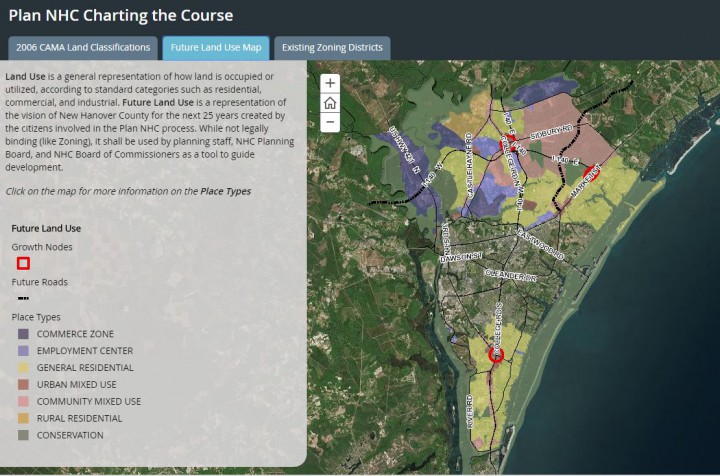
WILMINGTON — New Hanover County launched about two years ago an ambitious project to create a comprehensive plan to help guide development decisions in the rapidly growing and quickly urbanizing coastal county during the next 25 years.
At the time, Carolinas Cement Co., a subsidiary of Titan America LLC, was seeking various approvals necessary to dramatically expand its terminal and mining operations off Holly Shelter Road, near the Northeast Cape Fear River, to a massive cement-production plant. But on March 10, Titan pulled the plug on that plan.
Supporter Spotlight
While the company cited market conditions as the reason, few doubted that the decision was likely made more feasible by a bruising, nearly eight-year battle, led by the N.C. Coastal Federation, which questioned the effects the plant would have on air quality, water quality and life in general in the Castle Hayne area of northern New Hanover.

Ruth Smith, communications officer for the county, insisted recently that Titan’s decision has had “no impact” on the comprehensive plan’s progress. “We’re not looking at specific projects,” she said, but others see an opportunity to recalibrate for the future.
“We’d like to see the whole community look at the possibilities of that corridor along the Northeast Cape Fear River corridor,” said Mike Giles, the federation’s coastal advocate in Wrightsville Beach, a few minutes’ drive from the Titan site. “The area could be an unbelievable economic engine for the community.”
Giles said the federation would like to see discussion of ways to develop the area with a focus on quality of life. “Rather than focusing on a single, heavy, polluting industry, or polluting industries, we’d like to see a vision that would encompass good jobs that would also protect the natural resources,” he said.
Titan’s site covers more than 1,000 acres in total, and Bob Odom, general manager of development for the now, at least temporarily abandoned expansion project, said there are no plans to sell any of the land or to develop it. Neither, he said, are there are any plans to seek or support any efforts to change the allowed use of the property, which is zoned I-2, or heavy industrial. Instead, he said, the company would strongly prefer that the county not allow any significant residential development nearby, since that kind of development is incompatible with mining operations.
Supporter Spotlight

Odom said he doesn’t foresee any short-term end to those operations.
The company, Odom said, hasn’t participated in the comprehensive plan project, nor has it been asked to do so. But, he said Titan is following the process.
So, of course, is Karen Dunn, who is the clean communities’ coordinator for the federation’s Wrightsville Beach office. She has served on comprehensive plan committees throughout the process and has been relatively pleased by the work, which is near the point where it will go to the county planning board for a recommendation to the county board of commissioners.
“I see it (the comprehensive plan) as a great opportunity,” she said recently. “It’s a chance for people to come together, as part of a visioning process, to say what they would like to see happen.”
She said the federation, as part of the coalition that fought the Titan expansion, should be at the forefront of that process. “We will continue to press for public participation,” she added. “That’s my passion.”
The real key, Dunn said, might be what happens after the comprehensive plan is approved and adopted. The next step is turning the county’s piecemeal development rules into a unified development ordinance. That could include rezoning certain areas, the possibility to which Odom referred.

The county’s zoning map shows property to the west of Titan’s industrial site, close to the river, as a conservation district. Land to the southwest is zoned general residential, and to the south, it’s shown as “community, mixed use.” The process for developing a unified ordinance will include opportunities for residents to weigh in.
Dunn noted that the county’s zoning classification system dates back to the late 1960s, and there have been relatively few significant changes since then. That was a period before the U.S. Clean Water Act, even before the state’s ground-breaking Coastal Area Management Act, which required land-use plans in all 20 coastal North Carolina counties.
Thinking has changed, Dunn said, and so have philosophies of what kinds of development should occur in specific locations.
Ideally, she said, the county’s development ordinance would include entirely new zoning classifications to reflect the philosophical changes regarding proper land uses in specific areas, particularly those close to water, and even more particularly those close to rivers as environmentally and culturally significant as the Northeast Cape Fear River. The county, she said, should also strongly consider incorporation of conditional-use zoning, which countless communities have used to require specific measures in exchange for development approvals.
“It’s critical,” she said, “to get a good comprehensive plan in place, because that will guide what happens with the UDO (unified development ordinance).”
Giles said the federation wants a more inclusive discussion about the region’s overall economic strategy. He called for a focus on sustainable development that takes advantage of, but doesn’t adversely affect, natural resources. A community discussion of the future and economic and environmental strategy for the entire lower Cape Fear River is needed, he said. Improvements to the special-use permit process in the county, especially with regard to industrial development, are key. The federation has taken the lead in that effort, presenting ideas to the county manager, Chris Coudriet.
The federation, with money from a $25,000 grant, developed ideas that would allow the county more control of industrial development. The proposal would amend the existing special-use permit process, which until fierce opposition arose appeared to pave the way for the Titan project and allowed existing industry to expand without special permitting.
Finally, Giles said, the federation is focused on a task force strategy, which it has used, “to address protection of groundwater aquifers as one of the primary sources of clean drinking water.”
The U.S. Geological Survey, he said, has identified the southeast coast of North Carolina as one of six areas of concern in the U.S. in terms of sustainable water supplies for the future. Meanwhile, the state-level Lower Cape Fear River Study bill report, championed by Rep. Rick Catlin, R-New Hanover, is due out for comment later this year. This research is important, not only because the Titan project would have used untold amounts of water, but also because New Hanover is growing so quickly.

Officials estimate that in the next 25 years the county will gain about 123,000 new residents, bringing the total nearly 337,000. That’s roughly equivalent to adding another Wilmington.
The plan, according to county officials, is to finish the comprehensive plan this summer, and to begin implementing it. Developing the new development ordinance is expected to take two or three years, with the help of an outside consulting firm.
Dunn said she thinks that’s a good idea, as an outside firm will help ensure not only fair play, but also avoid even the appearance of bias, a critical factor in dealing with the residential, commercial and industrial development community, as well as environmentalist and conservation groups, such as the federation.
Although the comprehensive plan development has slowed in recent weeks because of unexpected issues raised by developers and other business interests, Dunn said she remains convinced the process has been a good one because it values public participation.
“It’s better to have a broad-based stakeholders’ group involved, and a lot of public discussion,” she said.
Smith, the county spokesperson, said public hearings on the comprehensive plan should be announced soon, but there is no set timetable for the plan to go to county commissioners for approval.
Learn More







